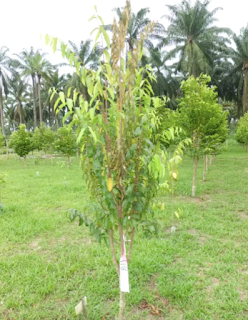Stem borers are caterpillars insects from the MOTH / BEETLE. Mature adult beetles will lay the eggs and hatch into larvae. Larvae dig into the trunk and takes few months to mature. The larvae will tunnel along the branch to the branches and the main stem. It emits frass through holes drilled. Effect of attack can be seen when we see the leaves and shoots become yellow and dry.
Sâu đục thân là loài sâu bướm thuộc loài MOTH/BEETLE. Bọ cánh cứng trưởng thành sẽ đẻ trứng và nở thành ấu trùng. Ấu trùng đào sâu vào thân cây và mất vài tháng để trưởng thành. Ấu trùng sẽ đào hầm dọc theo cành tới cành và thân chính. Nó phát ra phân qua các lỗ được khoan. Hiệu quả tấn công có thể thấy rõ khi chúng ta thấy lá và chồi trở nên vàng và khô.
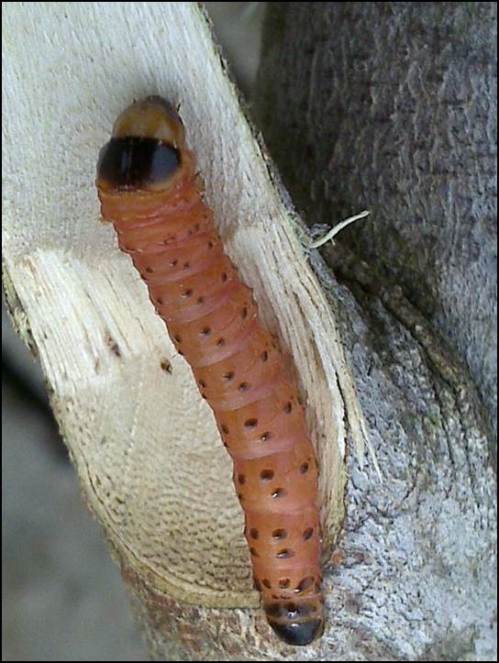
Aquilaria stem borer worm, attack may be fatal if tree is young.
The presence of these stem borers in mature Aquilaria tree should not to worry about but it gives a positive impact that will assist in the formation of agarwood in the future. However, if these stem borers attack happened in the early planting stage (<5 years), it is better taken seriously. This is because it can cause the stem broken because it is consuming the internal tissues of the tree.
Sự hiện diện của sâu đục thân này trên cây Dó bầu trưởng thành không đáng lo ngại nhưng nó mang lại tác động tích cực hỗ trợ hình thành trầm hương sau này. Tuy nhiên, nếu sự tấn công của sâu đục thân này xảy ra trong giai đoạn đầu trồng (<5 năm) thì tốt nhất nên xử lý nghiêm túc. Điều này là do nó có thể làm gãy thân cây vì nó đang tiêu thụ các mô bên trong của cây.
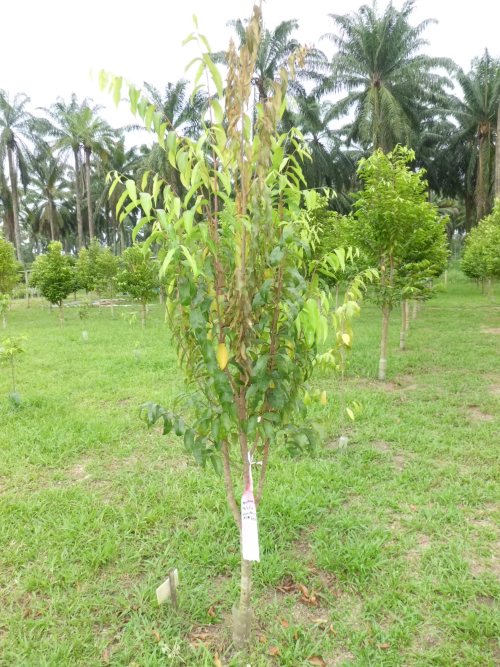
Upper branch had been bored by the worm, leafs were drying. The upper stem will be cut if no hope to recover. Worker noticed the attack was too late.

Result of upper stem 2 weeks later, photo taken 28/11/12

Early notice of the attack may safe the tree from fatality. Chemical insecticide may be injected through the entry point bored by the worm.

Photo showed stem borer in position.
7-month seedling was attacked by stem borer worm, the stem was too soft to support its upper weight when i slightly twisted it and broken into 2 halves.
Cây con 7 tháng tuổi bị sâu đục thân tấn công, thân cây quá mềm không thể đỡ được trọng lượng phía trên của nó khi tôi vặn nhẹ và bẻ làm 2 nửa.



Earlier rectification/ Chỉnh sửa trước đó: :
Keep the ground clean, the weed should not be too dense. You will notice the frass (dropping) from the stem borer which is round and pale in colour. It looked like granular fertilizer when i first saw. Or when you see the leaves and shoots become yellow and dry. These will alert you something is out of order for further inspection.
Giữ mặt đất sạch sẽ, cỏ dại không nên quá rậm rạp. Bạn sẽ nhận thấy phân của sâu đục thân có hình tròn và màu nhạt. Lần đầu tiên tôi nhìn thấy nó trông giống như phân bón dạng hạt. Hoặc khi thấy lá và chồi trở nên vàng và khô. Những điều này sẽ cảnh báo bạn có điều gì đó không ổn để kiểm tra thêm.

Frass (dropping) on the ground, pale in colour.
Chemical control / kiểm soát hoá chất:
There are number of insecticide to inhibit the attack, by using syringe to inject the insecticide in dilution according to label instruction, its active ingredient are namely Carbofuran ; Fipronil ; Cypermethrin ; Emamectin benzoate ; Cartap hydroxide ; Clothianidin ; monocrotophos.
Có một số loại thuốc trừ sâu để ức chế sự tấn công, bằng cách dùng ống tiêm để tiêm thuốc trừ sâu với độ pha loãng theo hướng dẫn trên nhãn, hoạt chất của nó là Carbofuran; Fipronil; Cypermethrin; Emamectin benzoat; Cartap hydroxit; Fabricianidin; monocrotophos.
Biological control /Kiểm soát sinh học:
Ants, natural predators in preying the larvae and pupae of stem borer.
Kiến, loài săn mồi tự nhiên săn ấu trùng và nhộng sâu đục thân.

Preventative countermeasure/Biện pháp phòng ngừa :
Stem borer control is difficult since larvae penetrate the stem and it is too late for control when the damage begins. Applying chemical pesticide is almost useless and NOT applicable to agarwood when it is meant for human consumption, whether it is for tea or oil distillation. Click “here” for further reading.
Việc kiểm soát sâu đục thân rất khó khăn vì ấu trùng xâm nhập vào thân cây và đã quá muộn để kiểm soát khi thiệt hại bắt đầu. Việc sử dụng thuốc trừ sâu hóa học gần như vô dụng và KHÔNG áp dụng được cho trầm hương khi nó được dùng cho con người, cho dù đó là để chưng cất trà hay dầu. Bấm vào “đây” để đọc thêm.
Pros and cons of stem borer infection
Ưu và nhược điểm của nhiễm sâu đục thân
For a mature tree, 20cm in BHD it should be able to withstand the attack. It depends on how you want the trees to be stressed for its final harvest. Frankly speaking, i will prefer the trees to be heavily stem borer infection, i am NOT keen on liquid inoculant for fast food harvest.
Đối với một cây trưởng thành, 20 cm ở BHD phải có khả năng chịu được sự tấn công. Nó phụ thuộc vào cách bạn muốn cây chịu áp lực cho vụ thu hoạch cuối cùng. Thành thật mà nói, tôi thích những cây bị sâu đục thân nặng hơn, tôi KHÔNG quan tâm đến chế phẩm lỏng để thu hoạch thức ăn nhanh.
If you meet someone who is prone to liquid inoculant, you will bounce to completely reverse explanation. There is no “Right ” or “wrong” in this practical approach of man-made intervene.
Nếu bạn gặp một người dễ bị tiêm chất lỏng, bạn sẽ có cách giải thích hoàn toàn ngược lại. Không có “Đúng” hay “sai” trong cách tiếp cận thực tế do con người tạo ra này.
You must know what you want? Like i said, engaging a contractor to perform the inoculation, is like getting a prostitute for service. A contractor CAN’T satisfy all the customers requirement, he is familiar and comfortable with his own way … and without a doubt he will lead you his way. But, that might not be your direction.
Bạn phải biết bạn muốn gì? Như tôi đã nói, thuê một nhà thầu thực hiện việc tiêm chủng cũng giống như thuê một gái mại dâm để phục vụ. Một nhà thầu KHÔNG THỂ đáp ứng mọi yêu cầu của khách hàng, anh ta quen thuộc và thoải mái với con đường riêng của mình… và chắc chắn anh ta sẽ dẫn dắt bạn theo con đường của mình. Tuy nhiên, đó có thể không phải là hướng đi của bạn.
Therefore, understanding the entire picture in agarwood business is important to autopilot to your direction.
Vì vậy, việc hiểu rõ bức tranh toàn cảnh trong kinh doanh trầm hương là điều quan trọng để tự động đưa ra hướng đi cho mình.
 White root disease is caused by pathogen called Rigidoporus microporus. This disease cause the existence of white rhizomorph thread that wrapping the roots, however cannot be seen due to position of roots deep in the soil. The clear indication of this disease are the existence of the fruiting body of Rigidoporus microporus which can be seen at the base of the Aquilaria trunk.
White root disease is caused by pathogen called Rigidoporus microporus. This disease cause the existence of white rhizomorph thread that wrapping the roots, however cannot be seen due to position of roots deep in the soil. The clear indication of this disease are the existence of the fruiting body of Rigidoporus microporus which can be seen at the base of the Aquilaria trunk. 

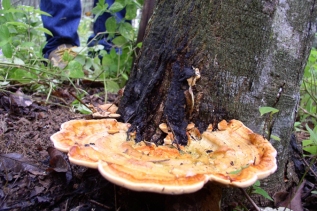






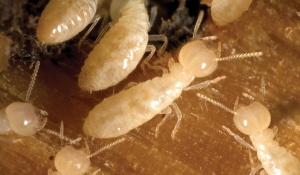 d, namely fipronil; imidacloprid; chorfenapyr have proven to be an excellent control product.
d, namely fipronil; imidacloprid; chorfenapyr have proven to be an excellent control product.
